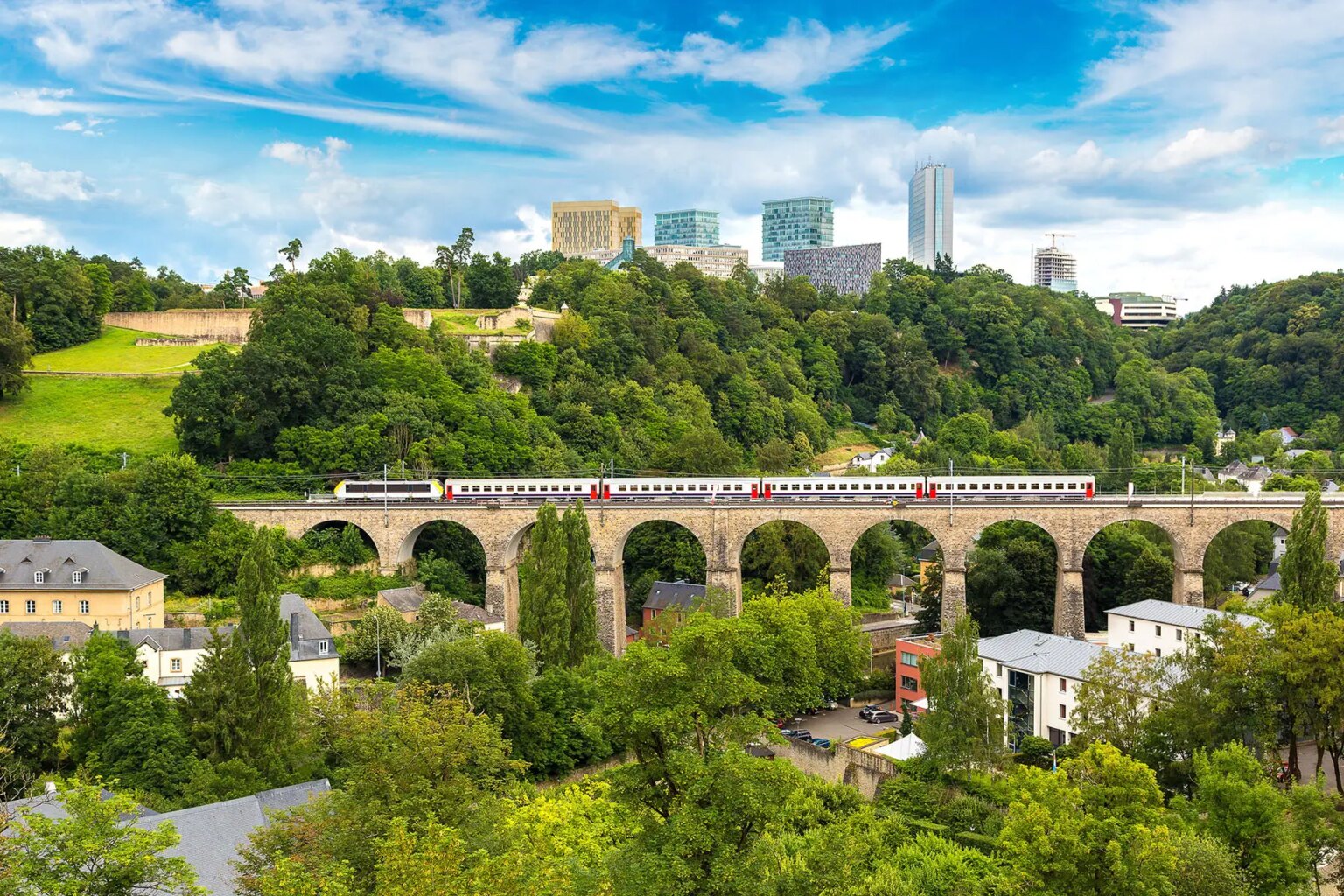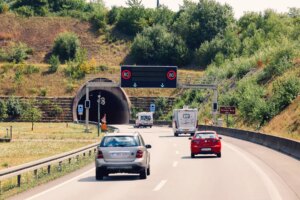Forget driving in Luxembourg; with so many scattered villages and towns (not to mention the thousands of cross-border workers), it’s no wonder that the country is aiming to make its public transport network the envy of Europe. To help you get moving, our guide to public transportation in Luxembourg covers the following topics:
- Public transport in Luxembourg
- Public transport apps in Luxembourg
- Trains in Luxembourg
- Buses in Luxembourg
- Trams in Luxembourg
- Taxis, ride-sharing, and other car services in Luxembourg
- Long-distance coaches in Luxembourg
- Airports in Luxembourg
- Other methods of public transport in Luxembourg
- Public transport discounts in Luxembourg
- How disability-accessible is public transport in Luxembourg?
- How environmentally friendly is public transportation in Luxembourg?
- Public transport safety in Luxembourg
- Making a public transport complaint in Luxembourg
- Useful resources
Public transport in Luxembourg
Despite its size, Luxembourg has a dense and accessible public transport network that spans the entire Grand Duchy and also provides punctual connections to neighboring countries for cross-border commuters. Trains, trams, and buses in the country are clean, efficient, and user-friendly.
In March 2020, Luxembourg did something that no country had ever done before: they made all public transportation free. While many cities and countries have trialed fare-free networks or free transportation for residents, Luxembourg’s bold step to make the entire network free of charge for everybody is a signal that the Grand Duchy takes mobility (especially those struggling with the cost of living in Luxembourg) seriously.
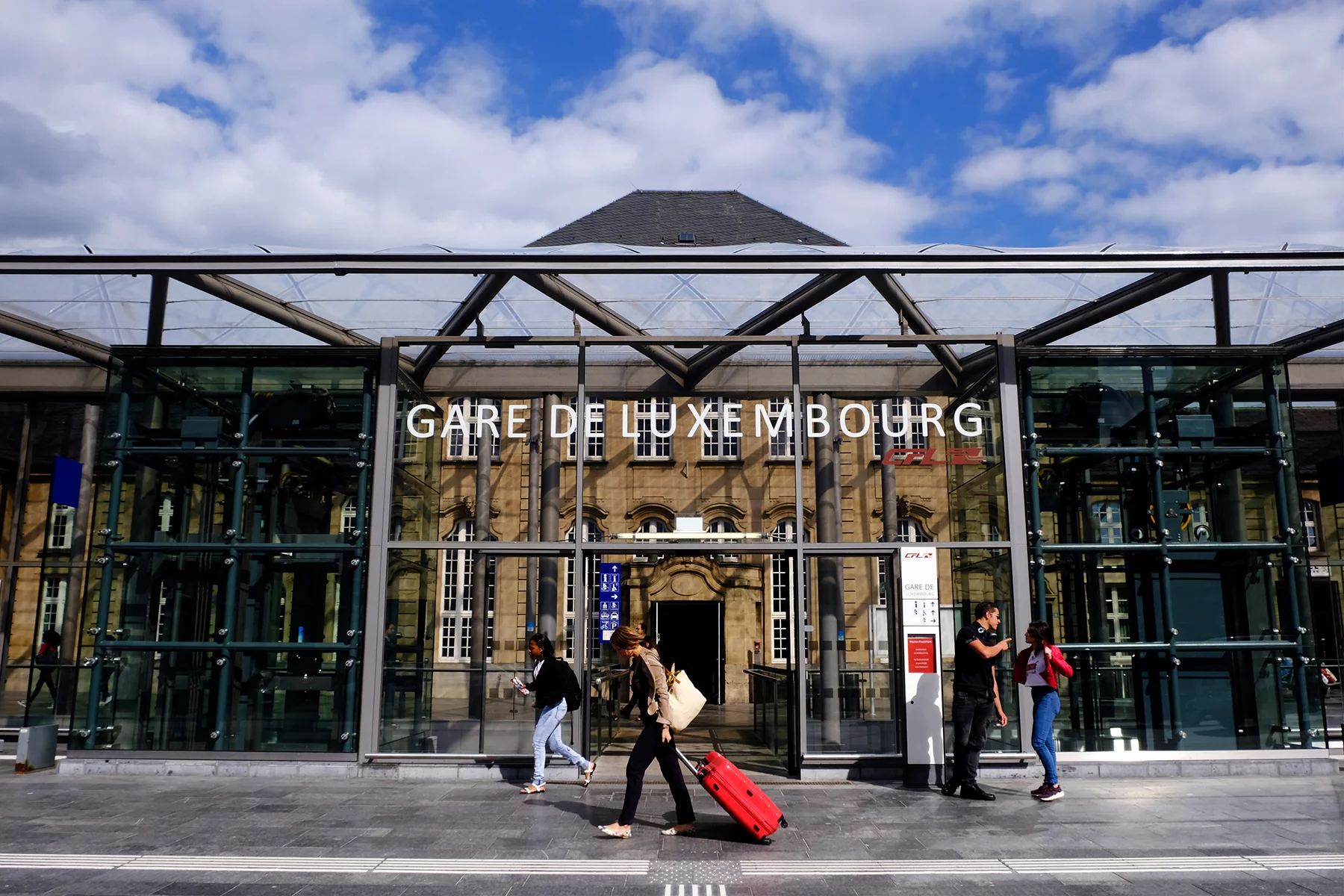
There are two exceptions to the free transport rule in Luxembourg:
- First-class train carriages for passengers over the age of 12
- Cross-border travel to Belgium, France, and Germany
The Administration des transports publics (ATP) oversees public transport in Luxembourg, including coordinating services between the country’s different operating companies. Public transport operators in Luxembourg operate a certain mode rather than solely focussing on a region. Luxembourg has five public transport authorities serving the country:
- Autobus de la ville de Luxembourg (AVL)
- Société nationale des chemins de fer luxembourgeois (CFL)
- Régime général des transports routiers (RGTR)
- Transport intercommunal de personnes dans le canton d’Esch-sur-Alzette (TICE)
- Tramway de Luxembourg
Altogether, the five public transport companies in Luxembourg operate a wide array of trains, buses, trams, and even a funicular.
Public transport apps in Luxembourg
For a compact country, Luxembourg has a great selection of local public transport apps available to travelers, whether you live in Luxembourg City or one of the smaller Luxembourgish municipalities.
If you’re just traveling by train, CFL has two separate apps for passengers: one for domestic travel and one for international travel. CFL Mobile lets users search for itineraries, buy tickets, and set up push notifications for your route; CFL International does the same, but for international journeys.
For multimodal journeys or trips with the bus or tram, the APT also offers up a pair of apps. For trip planning and live information on parking or bike-sharing, the mobiliteit.lu app is available for Android and iOS.
Trains in Luxembourg
Luxembourg’s national train operator is the Société nationale des chemins de fer luxembourgeois, or CFL for short. CFL served over 25 million passengers in 2019 on six main lines that crisscross Luxembourg. Trains in Luxembourg are punctual and it’s also a point of pride for the CFL; as a matter of fact, CFL publishes monthly punctuality reports in English, French, and German.
Second-class train travel within Luxembourg is free; in fact, tickets are not necessary to travel by train.
Multilingual Luxembourg only uses a single language on the rails. Announcements and departure boards at train stations in Luxembourg are in French only, although the CFL’s website and apps also offer information in English and German.
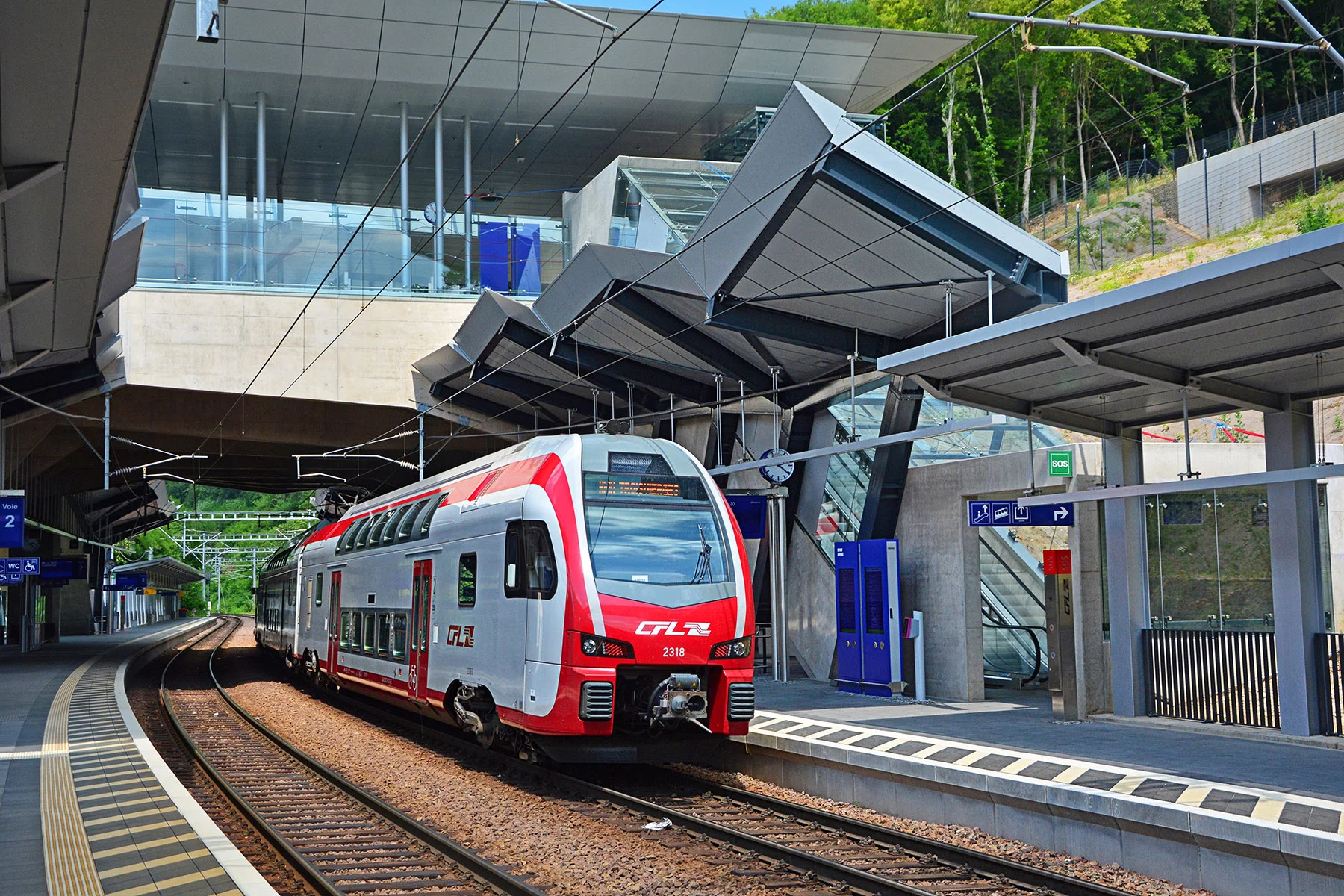
Passengers are free to bring bicycles, pets, and luggage on-board without an additional ticket. Space can be limited at peak hours, however.
CFL has two separate mobile apps depending on where you’re traveling: CFL Mobile (for domestic journeys) and CFL International (for international journeys). Both apps are available for Android and iOS.
Train tickets and costs in Luxembourg
As public transport in Luxembourg is free, tickets are not necessary on domestic routes.
Some travel on Luxembourgish trains does require a ticket, however. Tickets for first-class domestic travel cost €3 (valid for two hours); full-day tickets are available for €6. Travel beyond Luxembourg’s borders also requires a paid ticket.
Train tickets in Luxembourg are available at ticket machines, ticket offices (only at Gare de Luxembourg and Belval-Université), on the CFL’s website, as well as via the CFL’s mobile apps. Tickets are also available on-board with an additional €1 surcharge.
CFL also offers a range of monthly and annual tickets, including:
- Domestic short-distance first-class tickets (€37.50/month or €330/year)
- Domestic full-network first-class tickets (€75/month or €660/year)
- Full-network first-class ticket for senior citizens or Seniorekaart (€200/year)
- International passes for cross-border travel to or from Belgium, France, or Germany
Season tickets are loaded onto a mKaart, which is a contactless smart card that can also be used with some bike-share services in Luxembourg.
Train timetables and maps in Luxembourg
Trains in Luxembourg run throughout the day, although late-night travelers will probably need to resort to the night bus to get around the country effectively.
Itinerary planning as well as conventional timetables are available widely online. Travelers can use Google Maps or CFL Mobile to plan a trip on a smartphone. CFL also has full timetables for each individual train line in Luxembourg.
Train stations in Luxembourg
The size and facilities of train stations in Luxembourg can vary quite widely. Gare de Luxembourg, the main station of Luxembourg City, has shops and a staffed international ticketing desk; others, like Dudelange-Burange, are single-platform stations with fewer than 10 bicycle parking spaces. Urban train stations, however, have plenty of facilities and multilingual staff available to help passengers.
Travelers can also browse all of the services available at specific train stations in Luxembourg on the CFL’s website.
International trains in Luxembourg
Considering its geographical position at the crossroads of three other European countries, Luxembourg’s international rail connections are quite strong.
Luxembourg’s national rail carrier, the CFL, offers direct service to neighboring countries:
- Belgium: Arlon, Athus, Brussels, Liège
- France: Audun-le-Tiche, Longwy, Metz, Nancy, Thionville, Volmerange-les-Mines
- Germany: Cologne, Düsseldorf, Koblenz, Trier
International services from other carriers include:
Buses in Luxembourg
There are three public transport companies that provide bus services in Luxembourg:
- Autobus de la ville de Luxembourg (AVL)
- Régime général des transports routiers (RGTR)
- Transport intercommunal de personnes dans le canton d’Esch-sur-Alzette (TICE)
Buses operated by AVL and TICE only serve stops within Luxembourg and are more regional in focus. For cross-border bus routes, passengers ride RGTR buses.

In fact, RGTR has the largest bus network in the country, operating 342 lines in total. AVL runs 38 lines within Luxembourg City and nearby municipalities, while TICE focuses on the southwestern canton of Esch-sur-Alzette with 15 lines serving the area.
Bus tickets in Luxembourg
Public transport within Luxembourg is free for everyone, and that also applies to the three bus networks.
For cross-border buses, prices are determined by where you are traveling to or from outside of Luxembourg. Pricing falls into one of two regional ticketing zones: RegioZone 1 or RegioZone2.
RegioZone 1 covers most of the nearby municipalities in Belgium, France, and Germany. Ticket prices are as follows:
- Two-hour ticket: €3
- One-day ticket: €5
- Monthly ticket: €40
- Annual ticket: €360
RegioZone 2 is for German destinations that are further afield, such as Dillingen or Saarbrücken. Ticket prices are as follows:
- Two-hour ticket: €5
- One-day ticket: €9
- Monthly ticket: €85
- Annual ticket: €750
Cross-border bus tickets are available from the bus driver or on the mShop if you travel with a mKaart.
Luxembourg’s public transport authority maintains a map of the two RegioZones to help travelers get the right cross-border bus ticket.
Bus timetables and maps in Luxembourg
Buses in Luxembourg run throughout the day, including late at night. Regular routes generally run from 05:00 to 24:00. Night buses are also available if you miss the last normal bus.
Timetables and live departure information in Luxembourg are available in itinerary planning apps such as:
The three bus transport companies in Luxembourg also publish timetables and detailed route information on their websites:
Trams in Luxembourg
Prior to 1964, Luxembourg had a wide network of trams serving urban areas. The return of trams to Luxembourgish streets was surprisingly recent, resuming only in 2017. Luxtram manages Luxembourg’s tram network.
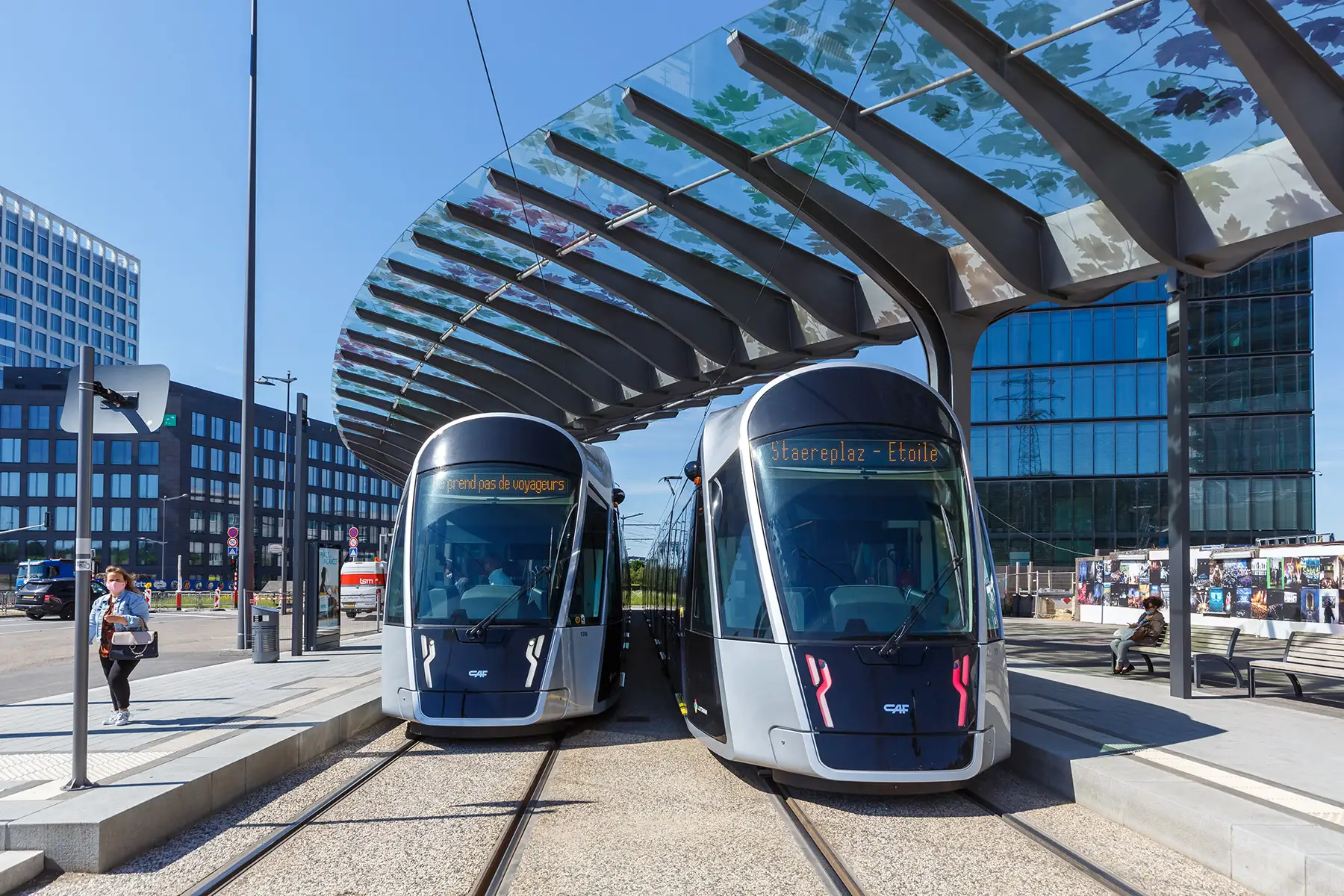
Currently, there is one tram line operating in Luxembourg: Line T1, which runs from Luxexpo to Stäreplaz/Étoile and carries over 30,000 passengers per day. A number of extensions are also under construction, including:
The extensions to Luxembourg’s tram service will result in a direct connection between the national airport and the main train station. With the extension to Cloche-d’Or, travelers will be able to use a single line to access Luxembourg’s airport, central station, the new business district in Cloche-d’Or, and the European Union institutions in Kirchberg.
As trams in Luxembourg travel entirely within the country’s territory, tram travel is free of charge for everyone.
Taxis, ride-sharing, and other car services in Luxembourg
Taxis are widely available in Luxembourg City. Passengers can hail a taxi in Luxembourg from the street (if you are more than 50 meters from a nearby taxi stand), a taxi stand, by phone, or through their app. There are multiple taxi companies in Luxembourg and pricing is liberalized; each company is free to determine their own prices, though they are obliged to provide a price list on their window. As a result, taking a taxi in Luxembourg is quite expensive in comparison to the rest of Europe.
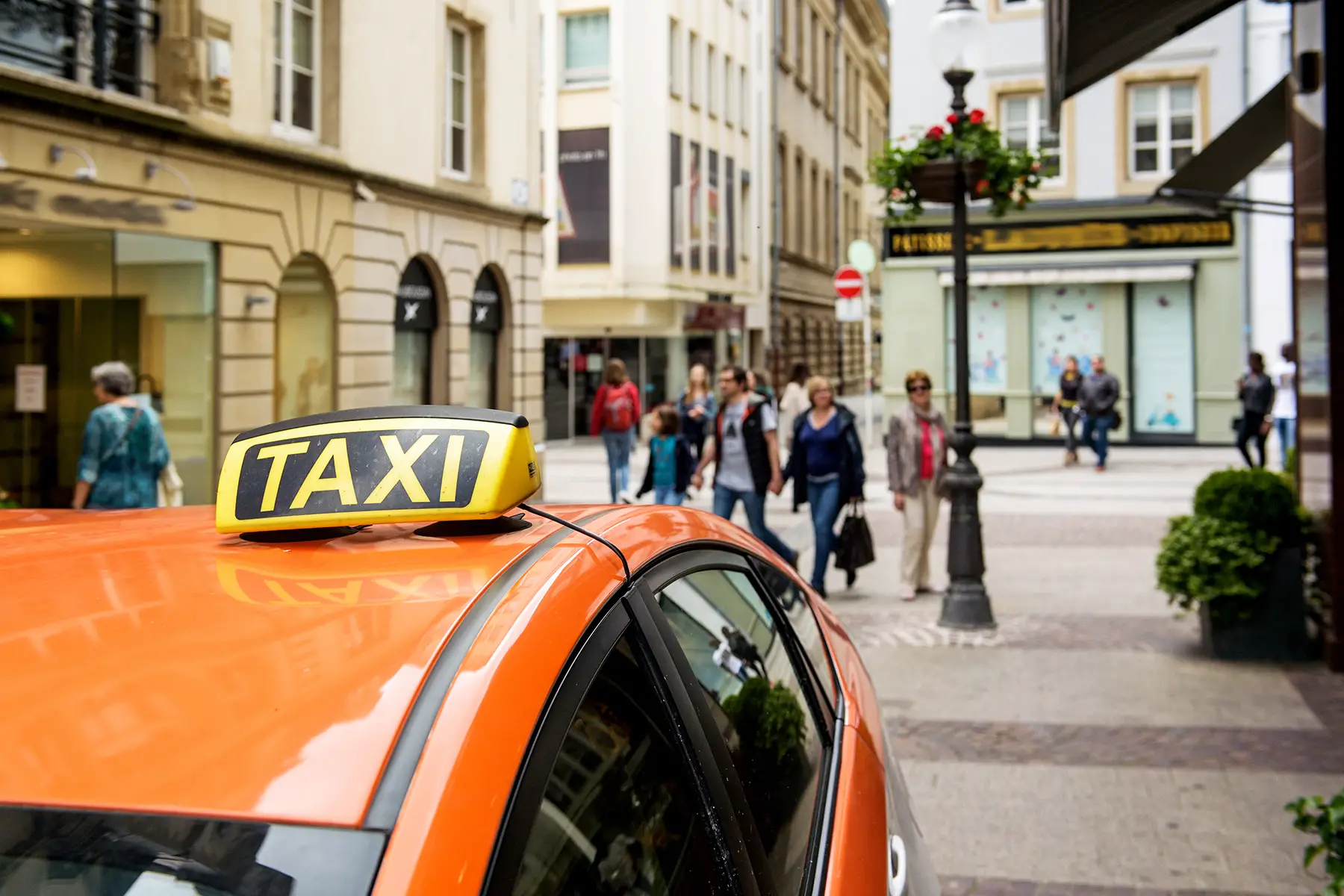
All taxis in Luxembourg have a number of stickers in their windows indicating it as such, in addition to the yellow and black sign on top of the vehicle. Drivers must take passengers on the shortest possible route unless you specify otherwise. Taxi drivers are not obliged to take animals in their car if they aren’t service animals; call the company in advance to ensure a driver is willing to transport your pet.
Some taxis are available through taxi-hailing apps, including companies such as:
Popular ride-hailing apps like Uber are not allowed to operate in Luxembourg, however.
Long-distance coaches in Luxembourg
As Luxembourg is a very small country, you can make the longest journeys in the country by trains and local bus routes. However, if you want to travel to another country, long-distance coaches can offer a cheaper alternative to the train and a more environmentally friendly option than flying.
Flixbus provides long-distance coach travel between Luxembourg and several other European countries. These buses provide a comfortable coach ride, often with power outlets, WiFi, and refreshments. There are stops in Luxembourg City, Differdange, Esch-sur-Alzette, and Rodange. Check when booking to find the precise location of your stop.
Airports in Luxembourg
The Directorate of Civil Aviation (DAC) oversees air travel in the country. As Luxembourg is part of the EU, it is also a member of the EASA.
Luxembourg has one international airport: Luxembourg Airport in Findel. It had around two million passengers in 2021, with 800 flights per week on average. Most of its flights go to other European countries – for direct flights to farther away, your closest options are likely Frankfurt Airport, Paris Charles de Gaulle, and Brussels Airport.
You can reach Luxembourg Airport with bus lines 16 and 29 from elsewhere in Luxembourg, or bus line 117 from Trier, Germany. Bear in mind that this bus charges a fare. It’s also worth checking the Flibco Bus website to find out about connections to the airport from Belgium and elsewhere in Germany.
Other methods of public transport in Luxembourg
Beyond the trains, buses, and trams, Luxembourg is home to one other form of public transport: the funicular. Funiculars use cable-driven cars to ascend and descend steeper, with two cars traveling in opposite directions in order to counterbalance one another.

The Pfaffenthal-Kirchberg Funicular, which is run by the national rail company (CFL), connects Gare de Pfaffenthal-Kirchberg with the Kirchberg plateau after an ascent of 200 meters. Just across the river from the funicular is another fairly unique way to travel: the Panoramic Elevator of the Pfaffenthal.
Cycling is also increasingly popular as a way of getting around Luxembourg, especially considering the improving state of cycling infrastructure in Luxembourg. To that end, Luxembourgish authorities introduced the mBox, which is a network of bicycle storage lockers. Travelers can register for the service and add it to their mKaart. mBox is a free service, though there is a refundable deposit of €20. Don’t have a bike of your own? Vël’Ok operates a comprehensive bike-share program in Luxembourg.
Public transport discounts in Luxembourg
As you’ve certainly heard, public transport in Luxembourg is free for all passengers. As a result, the only discounts that apply are either for first-class train carriages within Luxembourg or cross-border travel.
Discounted tickets are available for:
- elderly individuals (older than 60)
- students (younger than 30)
Contact the public transport authority in Luxembourg that you plan on traveling with to secure a discounted travel pass.
How disability-accessible is public transport in Luxembourg?
Full accessibility across all modes of public transport in Luxembourg is not quite possible at every single stop, although the situation is generally quite good. Bus operators are swiftly deploying low-floor buses and improving audio announcements on-board, while local governments are also improving the positioning of bus stops for one-step or no-step access. Tactile surface indicators are increasingly found in transportation hubs both large and small.
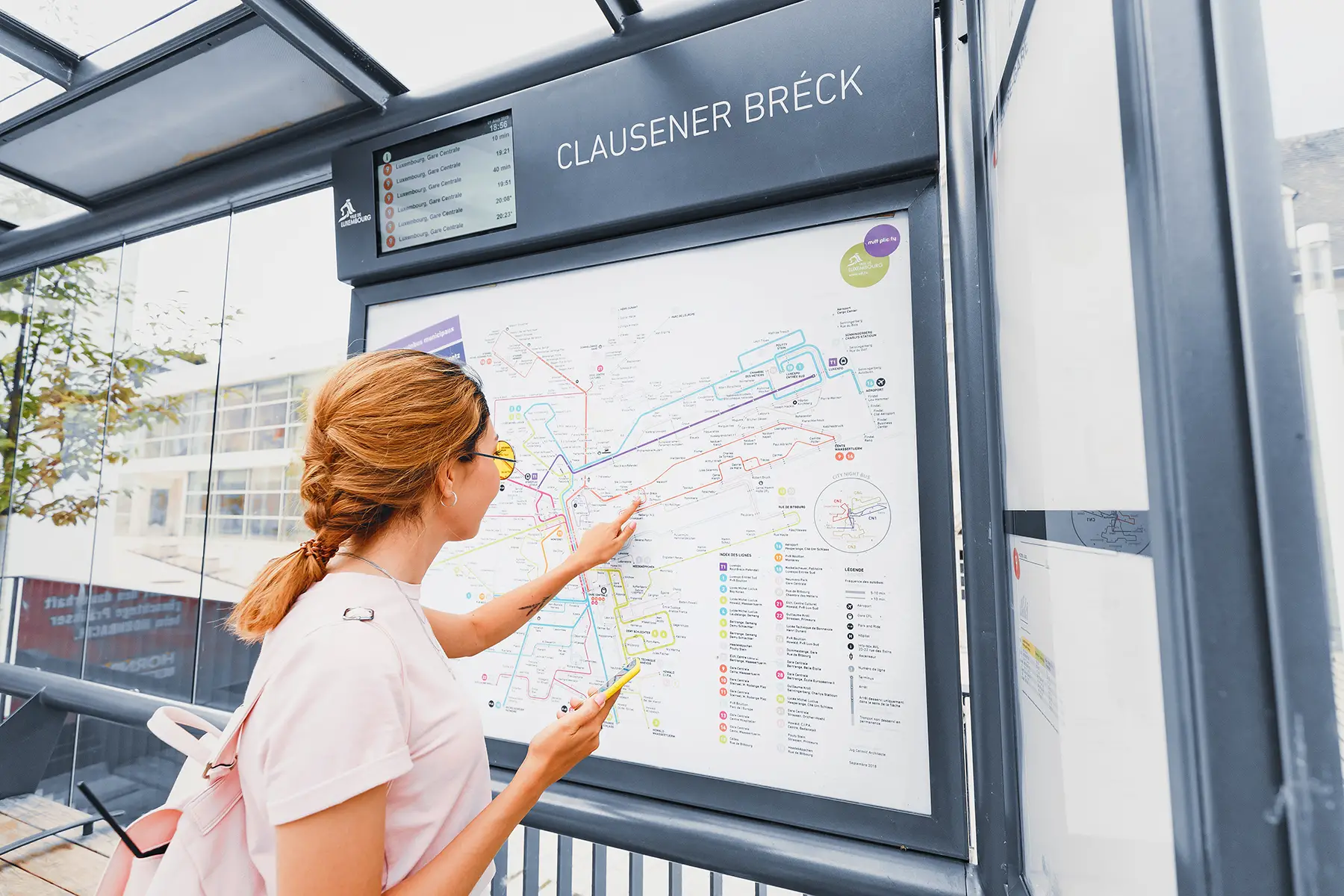
On top of the infrastructural improvements, Luxembourg has an on-demand service for those with limited mobility. Adapto provides public transport upon request within Luxembourg; passengers can reserve rides with Adapto’s apps for Android and iOS devices or by phone (2465-2465).
How environmentally friendly is public transportation in Luxembourg?
In 2017, then-Minister for Sustainable Development and Infrastucture, François Bausch, said Luxembourg sought to ensure 25% of all trips in the country were by public transport by 2020. While the country failed to meet the target, Luxembourg is making gains when it comes to getting cars off the road; Eurostat data shows that the percentage of passenger trips by car decreased from 84.3% in 2009 to 82.9% in 2019.
Although the numbers now might be small, Luxembourg’s ambitions aren’t. Removing fares from Luxembourg’s public transport network isn’t just a nice way to save a few euros while crossing town; it shows that Luxembourg’s government is ready to commit funding towards new facilities, clean transit vehicles, and rapidly expanding routes over the long run.
Public transport safety in Luxembourg
Traveling with public transport in Luxembourg is both efficient and safe. Considering the low crime rates in Luxembourg, your biggest concern as a traveler is missing a bus that only runs once per hour. As with any other country, it’s worth keeping a close eye on your belongings in and around major train stations and other transit hubs in Luxembourg.
On the bus, passengers must move towards the rear; this is to ensure that the bus driver’s view isn’t blocked by standing passengers. If a bus doesn’t stop to pick up passengers at a bus stop, it’s probably because the bus is full and there isn’t a safe place for new passengers to sit or stand.
Making a public transport complaint in Luxembourg
Complaints should generally be made to a specific transport authority in Luxembourg. Most authorities have a contact form for this, including:
If the public transport authority in Luxembourg that you wish to lodge a complaint with doesn’t have a contact form on their website, you can also get in touch directly with the Verkéiersverbond.
Lost property can either be returned to you either by contacting the company directly or via the Service national des objets trouvés (National Lost Property Office) of the Grand Ducal Police.
Useful resources
- AVL – municipal bus services in Luxembourg City
- CFL – Luxembourg’s national rail carrier
- Luxtram – Luxembourg’s tram operator
- National Cycle Path Network in Luxembourg – route maps and information on riding a bike in Luxembourg
- TICE – regional bus services in the canton of Esch-sur-Alzette
- Verkéiersverbond – oversight body for Luxembourg’s public transport authorities
